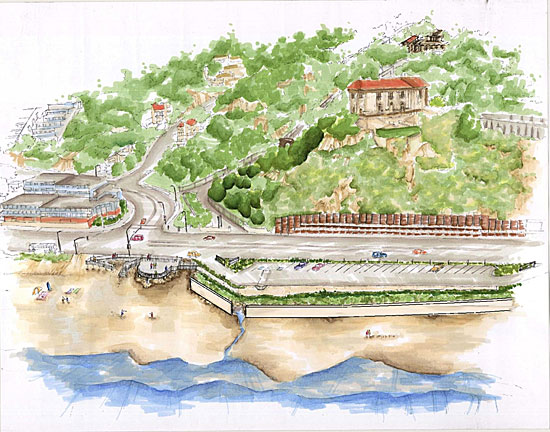Transforming a prime beach vista
January 8, 2013
The dirt lot overlooking the sand at Coastline Drive and Pacific Coast Highway has been vacant for three decades or so. Once it held a beachfront café owned by the restaurateur who started Gladstones. Then fire destroyed the place twice in five years.
So it sat, roped off and abandoned, little more than a cluster of faded parking spots and wooden pilings, as homeowners resisted the opening of a new restaurant along the already congested highway; after a while, passersby forgot that much of anything had ever been there.
This week, however, the county took the first steps in a $9.5 million plan to re-open the 1.9-acre site and make the beach there more welcoming to the public, starting with a spacious view deck that will not only provide improved passage to the shoreline, but also offer a stunning view down the coast toward Santa Monica Pier.
“This will be a great place to stop and listen to the waves and enjoy the sunset,” said Charlotte Miyamoto, chief of the county Department of Beaches and Harbors’ planning division.
“This will finally make use of an area that hasn’t been visited much,” Miyamoto added. “Right now, there’s a bus stop there and not much more.”
This wasn’t always the case. The site, at the northwesterly end of Will Rogers State Beach across PCH from the entrance to the Getty Villa, was once the location of an oceanfront café owned by Robert Morris, who in the 1980s was one of Los Angeles’ best known restaurant owners.
The spot had had an eatery on it since 1976, when the county had approved a summer concession and snack bar. A later restaurant on the site, Jetty’s, started by Morris and a partner, burned down twice—once in 1979 and again in 1984, according to Coastal Commission records.
After that, hopes dimmed for a comeback; at one point, Morris announced plans to reopen the restaurant, rename it the Malibu Deck and make it part of a proposed “restaurant row” of oceanfront dining on public beaches.
But the pushback was powerful. Pacific Palisades homeowners protested that a new beachfront restaurant would worsen congestion and generate crime, garbage and noise. And the state and county couldn’t agree on a plan for such an enterprise on the site. (Much of the state’s beach property here is operated by Los Angeles County and the lease revenue would have helped the county’s general fund in the midst of a recession, but the state was less enthusiastic at the time.)
Eventually, without a design that met current building and safety codes for the area, the restaurant lease was terminated. The empty lot was roped off and anyone who stopped at the site in hopes of a beach shortcut had to make their way down a steep embankment, where they found little more than those 52 ghostly-looking pilings and a narrow strip of sand.
By the late 1990s, the county had begun to explore ways to reopen the site’s beach access, but it took years to negotiate a workable plan with the California Coastal Commission. Among the sticking points were initial plans to shore up the bluff with a rock-covered, sloping embankment, which coastal commissioners felt was too intrusive. Eventually, the commission called for a 610-foot-long, 15-foot-high seawall that added several million dollars to the cost of the project, but preserved more of the beach.
The current design, approved this week by the Board of Supervisors, will create a refurbished, 26-space parking lot next to a landscaped, 2,100-square-foot public view deck, from which pedestrians can access the beach via an ADA-compliant access ramp.
Construction costs are estimated at $5.76 million, plus some $3.5 million for plans, plan checks, consulting services and other construction costs. The project is set to break ground in April, with completion expected in October, 2014.
Posted 1/8/13














 405 bridge work causes a stink
405 bridge work causes a stink
